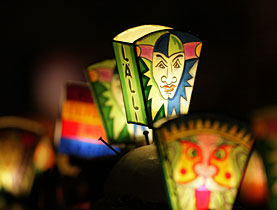Old carnival traditions die hard

At 4am on Monday, the normally sober, commercial city of Basel became a riot of colour, noise and exuberance as people started to celebrate Fasnacht.
The festival is an anomaly as in most Protestant areas Fasnacht, or carnival, is not usually celebrated. Its survival is a testament to Basel residents’ stubbornness and deep affection for the event – and to human nature.
In the early hours of the morning the city lights were dimmed and with the order “Achtung! Morgestraich – vörwarts marsch!” (attention, Morgestraich, forwards march!), the festivities began.
For three days ending on Wednesday Basel’s old town will be full to bursting with thousands of carnival participants marching, playing music or telling jokes.
“Basel is normally a serious city. It’s a city of commerce and trade and people don’t always have lots to smile about,” Dominik Wunderlin, curator at Basel’s Museum of Cultures, Switzerland’s largest ethnological museum, told swissinfo ahead of Fasnacht.
“On these three days you can certainly let off steam, although visitors from outside who know other Fasnachts are usually astounded how deadly serious Fasnacht is here,” said Wunderlin, whose museum holds a permanent exhibition on the event.
Rich in tradition
Basel’s carnival is rich in tradition. Fife-players and drummers form so-called Cliques, which join up in procession. They march in time, revealing the military influences of times gone by.
This is rather different to celebrations in other parts of Switzerland, or in other countries, where participants tend to run a little more riot.
Joining the Cliques are the Guggenmusik players, whose cacophonous sound has been described as “a cross between a big band and noise machine”.
Wild and wonderful costumes abound. And masks, or Larve as they are known in Basel – often depicting grotesque figures – are absolutely compulsory.
“If you understand the Basel humour and dialect you will see that people enjoy life at Basel Fasnacht and that people poke fun of the events of the past year,” said Wunderlin.
This is done through a choice of “sujet” or theme. This year the financial crisis is the target. Past victims have included, for example, former United States president George W Bush as well as hapless cabinet ministers.
Sujets can be seen on procession lanterns or in costumes. Schnitzelbänke singers are known for their satirical verses – and many of these are particularly pointed, as Baslers are famous for their biting wit.
Bucking the trend
That the city is home to Switzerland’s largest Fasnacht is perhaps surprising, given that Basel is Protestant. Carnival, which is supposed to end on Ash Wednesday, is normally celebrated in Catholic areas as a pre-Lent party.
Lucerne’s Fasnacht is among the most well known in Switzerland.
The Catholic carnival date was rescheduled by six days by a church council in the 11th century after Sundays were excluded from the 40-day fasting period before Easter.
From then until the 16th century there were two dates. The one ending on Ash Wednesday was generally observed by the upper echelons of society. The second, later one – which survives in Basel – was known as the farmers’ carnival.
“How it comes about that for hundreds of years people have stubbornly kept to this old appointment is not known,” said Wunderlin
Moves to ban
It is also not clear how Basel’s Fasnacht managed to survive the Reformation. Indeed the authorities tried to forbid carnival in 1546, arguing that as Protestants had abolished the fasting period, pre-Lent exuberance was no longer needed.
The celebration managed to survive, but it was not always popular.
“Until the end of the 18th century there were many negative testimonials in the court files showing that people didn’t necessarily like it when others went out into the streets during Fasnacht, making noise at night and running around in costumes,” Wunderlin explained.
“This was frowned upon and was actually forbidden, but people always try to break the rules and so it was done.”
Fasnacht in its present form largely dates from the 19th century, when the practice underwent a revival. Drawings and photos at the museum show how enthusiastic Basel residents were about it, even then. It is still known among locals as “the three most magnificent days” of the year.
Masks on display at the exhibition, beautifully made by Basel artists, attest to influences that pre-date the Reformation.
“Music and dance belongs to feasting and letting your hair down and masks are very closely interlinked with this. We know of many festivals in other cultures where masks are a component,” said Wunderlin.
Human nature
The true origin of Fasnacht, however – the Lent component may have come later – remains lost in the mists of time. But motivations for celebrating it may not have changed.
“I think people have a real need to let go and to dance. In earlier times, of course, there were fewer opportunities to do this, perhaps only Fasnacht or at weddings. Today it’s different, you can go to the disco everyday, so this aspect may have lost some of its attraction,” Wunderlin said.
“People also like to cover themselves, with make-up or masks. They are looking for a second face or even perhaps a chance for a man to be a woman or vice versa. This is understandable and is part of the human condition.”
Processions and self-expression are, if anything, gaining in popularity, added the curator. “Look at these Love and Street Parades, or summer carnivals in England from the 1960s,” he said.
“You hear of up to one million people taking part in the Zurich Street Parade, and for Berlin it’s similar. So there’s really a need.”
swissinfo, Isobel Leybold-Johnson in Basel
The Basel Fasnacht starts at precisely 4am on the Monday after Ash Wednesday each year and lasts for exactly 72 hours. Up to 20,000 people are said to participate. The event is organised by a committee.
During Morgenstraich, the opening event, the lights are turned off and lanterns are used – large parade lanterns and head-mounted smaller ones.
Parades that take place on Monday and Wednesday are called Cortège and follow defined routes. People throw treats, such as sweets and oranges, into the crowd from floats.
Traditional culinary delights include: flour soup and Käse- or Zwiebelwähe (cheese or onion quiche).
Until the 1920s masks were imported, although they were usually adapted to individual requirements. These were often glued canvas coated with wax, according to the Basel Museum of Cultures.
Later, two young Fasnacht enthusiasts decided to try their hand at papier maché masks. Local artists decorated them. These are now the norm and production usually starts in around November.
Harlequin is a popular mask as is the Waggis. The Waggis, dressed in a blue smock and sporting an outsize nose, is a way of poking fun at Alsace farmers, who used to come to Basel markets.

In compliance with the JTI standards
More: SWI swissinfo.ch certified by the Journalism Trust Initiative














You can find an overview of ongoing debates with our journalists here . Please join us!
If you want to start a conversation about a topic raised in this article or want to report factual errors, email us at english@swissinfo.ch.